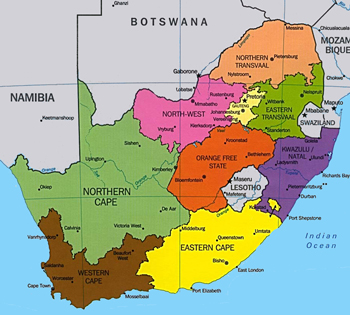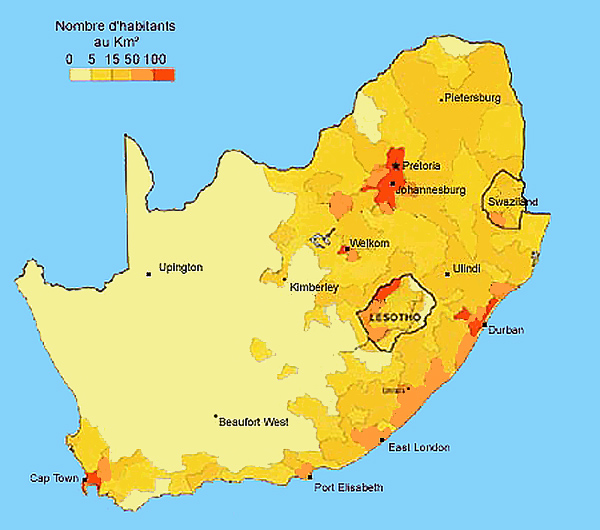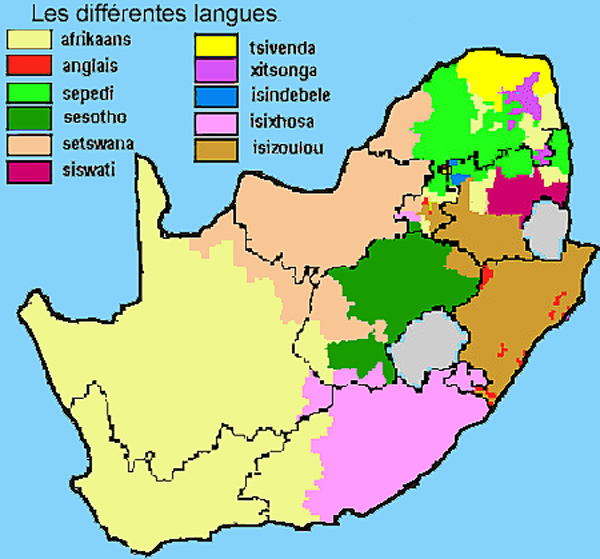
Travel Guide :
|
Namibia
|
|
South Africa
|
|
Botswana
|
|
Zimbabwe
|
Pictures :
|
Namibia
|
|
South Africa
|
|
Botswana
|
|
Victoria Falls
|
Site Links :
|
Travel journal
|
|
Videos
|
|
Forum
|
|
GuestBook
|
Compare :
|
Car Rental
|
|
Plane Tickets
|
|
Your holiday
|
|
Hotel
|
|
Currency Converter
|

| |||||||||||||||||||
South Africa : Population & TownsPrepare your travel to South Africa
I. Map and distribution of population by region
|
|||||||||||||||||||
|
|
I. Map of the density and distribution of South Africa
II. Provinces and administration.
|
In April 1994, four provinces and ten homelands, which were geographically and politically in South Africa have been dissolved to form nine new provinces included :
| |
 Provinces of South Africa
Provinces of South Africa
There are three official capitals :
- Administrative Pretoria. - Legislative Cape. - Judicial Bloemfontein. |
South africa population by province :Western Cape : Part of the former Western Cape Province .5 356 000 inhabitants. Northern Cape : North of the former Cape Province. 3 300 000 inhabitants. Eastern Cape : Independent homelands of Transkei, Ciskei and southeast of the former Cape Province. 6 400 000 inhabitants. KwaZulu-Natal : Natal and Zoulouland. 8 700 000 inhabitants. Free State : Orange Free State and some homelands integrated. 2 700 000 hinhabitants. North West : Former West Transvaal, Northern Cape Province and Bophuthatswana bantustan. 3 700 000 inhabitants. Gauteng : Former Pretoria-Witwatersrand-Vereeniging in the center of the Transvaal. 7 000 000 inhabitants. Mpumalanga : Former Transvaal region of East. 3 000 000 inhabitants. Limpopo : Former Transvaal region of North, called the Northern Province between 1995 and 2002. 5 300 000 inhabitants. |
| Johannesburg, the richest city in the country and home to the award, is generally regarded as its economic capital. | |
III. Ranking of the largest cities
|
Cape Town 2 984 100 inhabitants Durban : 2 531 300 inhabitants Johannesburg : 1 975 500 inhabitants Pretoria : 1 473 800 inhabitants Soweto : 1 465 200 inhabitants Port Elizabeth : 775 800 inhabitants Benoni : 487 700 inhabitants Vereeniging : 462 800 inhabitants Pietermaritzburg : 457 700 inhabitants |
East London : 423 500 inhabitants Tembisa : 376 600 inhabitants Bloemfontein : 349 000 inhabitants Boksburg : 348 100 inhabitants Vanderbijlpark : 338 000 inhabitants Newcastle : 309 400 inhabitants Krugersdorp : 272 400 inhabitants Welkom : 246 100 inhabitants Brakpan : 228 700 inhabitants |
Carltonville :220 400 inhabitants Springs : 214 600 inhabitants Uitenhage : 198 800 inhabitants Witbank : 198 500 inhabitants Alberton : 197 400 inhabitants Botshabelo : 185 900 inhabitants Paarl : 173 400 inhabitants Midrand : 168 700 inhabitants Kimberley : 166 100 inhabitants Upington : 50 000 inhabitants |
For the location of these cities, you can consult the following map:
- Map of South Africa
IV. Distribution of different peoples (ethnic groups)
Zulu: 22.9%Xhosa: 16.5%
Northern Sotho, 9.4%
Southern Sotho: 7.7%
Afrikaans: 6.7%
Tswana: 6.5%
Tsonga: 4.4%
Portuguese: 3.4%
English: 3.4%
Swati: 2.5%
Tamil: 2.3%
Venda: 2.2%
V. Breakdown of religions
In South Africa about 80% of the population follows the Christian religion.Most Christians are Protestants.
There are a number of Christian churches in South Africa and almost 85% of people are members of the church.
- Christian: 80%
- Animist 18%
- Minorities Hindu, Muslim and Jewish communities.
VI. Different languages
Source : 2012
|
Partners
|
Sitemap
|

